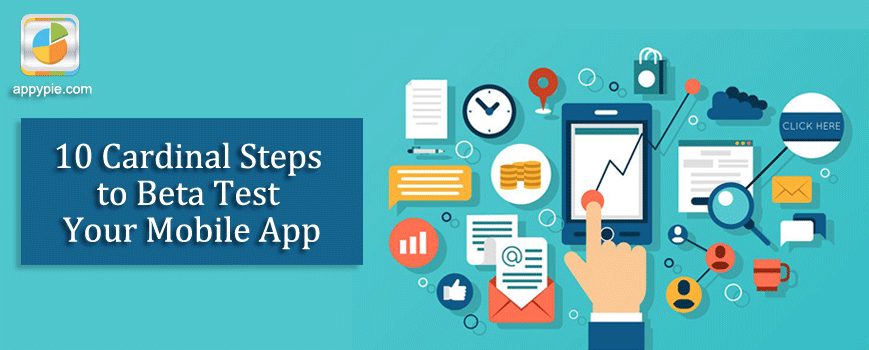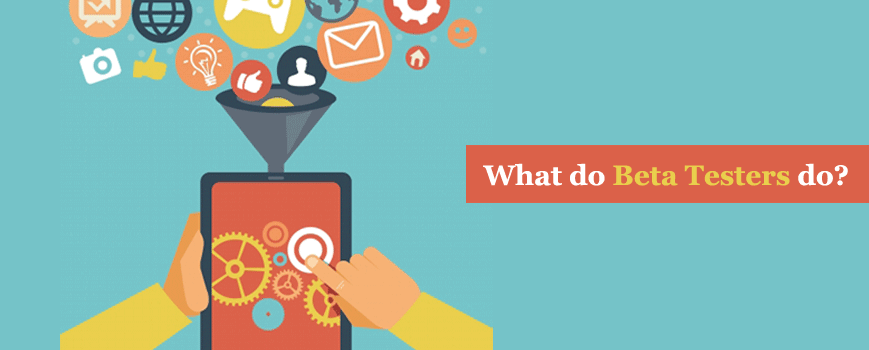10 Cardinal Steps to Beta Test Your Mobile App

App Builder Appy Pie, February 22, 2018: For a good app developer of any standing in the field, the importance of a thorough beta testing need not be stressed upon. Like any other product, your app too needs to be tested for any kind of flaws (bugs & crashes) before making it available to the customers. To make sure that you get rid of all your hidden bugs and problems within the app, beta testing is the only way to go. Beta testing is the secret for the best app quality, indeed.
There are some businesses however, who have (in a hurry, I presume) jumped this step and released their apps to the audiences without putting it through a rigorous bet testing procedure. It is these businesses that realize the importance of beta testing more than anyone else and they learn it the hard way.
What is beta testing?
Let’s talk about Alpha Testing first. Alpha testing is a simulated or sometimes actual operational testing by potential app users or independent testers at the developer’s site. It is only after the Alpha testing phase; the app goes into the Beta Testing phase. It may be considered as a kind of external user acceptance testing. It consists of releasing the beta versions of the app to a limited audience (not a part of the programming team), also referred to as beta testers. This release is done with the intent to reduce the number of bugs and any other flaws to the minimum. These versions may also be made available to the public at large so that the feedback field may be increased to a higher number of future users by delivering value earlier, for an extended period of time, which sometimes may be indefinite (like in case of Perpetual Beta).
What do the beta testers do?
Beta testers are those few who get to explore the yet unreleased apps and give a feedback about the experience they have had with it. It is this feedback which is of great value to the app developers as it helps them hone the product and make it audience ready. Among the numerous things that a beta tester does some of the most important ones are submission of bug reports, recommending new features, filling out surveys & polls, carrying out intense discussions with fellow testers, filling out mock testimonials or reviews even, and taking part in tester calls.
You know now what beta testing is and what is it that beta testers do. However, when it comes to how to actually do the beta testing for your app, it is natural to have some concerns, questions, and trepidations. Appy Pie has put the whole process in 10 steps to help you beta-test your own app and allay all your fears about it.
Step 1: Determine the suitable number of beta testers that you need.
Much like so many other decisions you would be making or have made in the process of developing your mobile app, deciding on the total number of beta testers is going to be a balancing act between what you want, and what you can afford. This is a crucial factor in determining your total budget of developing your mobile app. One extremely important fact to remember in this scenario is that not all the beta testers you pick are going to give you feedback of great value. There of course would be some who would provide feedback about the app experience in great detail, letting you know about the pain points and wow moments in the app. But there are bound to be a few who would simply say that they like the app and be done with it (even if they didn’t).
When you are trying to zero in on the number of testers, you can’t simply stick to something as low as 10, in the interest to keep the budget low. But it is equally important to not go overboard here, because collecting feedback from thousands of beta testers is going to be quite a task for you, eating away into your valuable time.
Typically, a team of 100 to 300 (depending on your budget and the complexity of the app) beta testers is equipped to test the app and ensure that it works well. This is that sweet spot where you get a sizeable amount of feedback to work with, without being bogged down with excessive information.
Step 2: Figure out the type of beta testers that you need.
It is not just the number of beta testers but also the type of the person you are going to get as a beta tester that is important. The type of beta tester that you finally decide to get depends primarily on the type of goals that you have set out and on the kind of experience and background they have.
In effect, there are two categories of beta testers that you may consider getting to test your app. The technical beta testers and the marketing beta testers. The technical beta testers would test out the apps and detect bugs in order to come up with constructive and valuable feedback to enhance your app. The marketing beta testers are typically social influencers who test your app out and raise awareness about your app among the target users. In this blog post though, I’m going to focus only on the technical beta testers for your app.
Step 3: Carefully build a beta tester persona.
If you are developing an app, it is only natural that you have developed a user persona who defined your target user group. In doing so there must be some questions that you asked and then answered, before you could come up with the persona. Questions about the nature of the problems they face, the nature of solutions that they need for these problems, the solutions that you as an app developer can provide to them, ways and features that would make this person use your app every single day, and the kind of features that they are looking for are critical in developing this fabled persona.
In a similar manner, you would need to work seriously on developing a beta tester persona. There are quite a few questions here as well. Two of the most important questions that you need to ask and answer if you want to build a beta tester persona are listed hereunder:
- What are the goals that you have set for your beta-testing phase?
- Are you looking to receive feature requests, detect bugs, procure an early audience, or raise awareness about your app?
Once you have figured out these answers you would have a clearer idea of the skill sets that you would want your beta testers to possess. It is this information and analysis that will help you create this persona.
Step 4: Establish a timeline and deadlines that you want to adhere to.
If you are serious about the app you are developing and have invested time, money, and other resources in it, then you must have had a timeline in place. Coming up with a timeline gives any project a much-needed structure. Besides, for beta testing if you do not have a formal timeline in place, it might just go on forever!
This, however, does not mean that you set up an unrealistically short timeline for beta tests. It is important that you do not rush through it. You must be thorough when it comes to beta testing your app. The beta testers must have enough time to test out all the features, elements, and aspects of the app, so that they can identify all the problems and issues.
The ideal timeline of the beta testing phase depends on a number of factors including but not limited to the goals you have set for the beta testing, the resources you have at your disposal, the limitations that your tester might have, and the number of test phases that you might choose to opt for.
Step 5: Look for suitable beta testers.
Beta testers, to most people might seem to be illusive, mystical creatures who can only be reached with great difficulty and especially challenging if you have super specific goals and requirements. There are a number of specialized platforms like Erli Bird, BetaList, Betabound, BetaTesters etc. where you can find beta testers to provide you with valuable feedback.
Apart from this, another way to find beta testers is through social media channels like Twitter, Quora, Reddit etc. sometimes it is as easy as using an appropriate hashtag like #testmyapp on Twitter, sharing the news on well chosen subreddits like /r/TestMyApp, or find testers answering questions on the topic on Quora.
Step 6: Make your app available to the chosen beta testers.
Now that you have found the right kind of beta testers, this is a big landmark. It is now time to distribute your app to the testers. If you are doing this for the first time, it is only natural that you be at a loss about how to accomplish that. There are a number of app distributing platforms that you can opt for and deliver your app to the beta tester, including but not limited to AppBlade, Google Play Console, Appaloosa, TestFlight etc.
Step 7: Find interesting ways to keep your testers engaged.
At this level, you have managed to develop a fairly specific tester persona, have found suitable beta testers for your app, and have found the right way to distribute or deliver your app to the chosen testers along with a specific and detailed set of instruction explaining what they need to do.
But do you think doing all this would ensure the delivery of desired results? It is you who wants them to do something now, that is give you a detailed feedback, so you would need to keep motivating them to keep using your app and keep sharing feedback.
You can incentivize this process by offering them codes that would give them free access to the premium features. This way, you wouldn’t have to invest a lot, but the testers would be lured to engage with your app for longer, giving you great return on your investment in the form of genuine and extensive feedback.
Step 8: Collate their feedback and opinions and take them under serious consideration.
The intention you had to beta test your app was to remove any bugs in your app and when you get the bug reports from your beta testers, you are definitely going to fix them. However, chances are, that you are also going to get some suggestions about improving your app. This can be a little tricky. You have worked for a long time with a lot of dedication to incorporate the features that you liked best into your app, and it may turn to be that most of your beta testers are not really enjoying some or at least one of them. What do you do now?
The thing is you have a community of beta testers that you have chosen from among a huge pool and have entrusted them with your app even before its launch. Now, you have to have some faith in them! Hence, make sure that you at least consider all the suggestions that you get from them and see if they are of any value to you in making your app better.
Step 9: Make good choices.
So, you have a bunch of suggestions for improving your app coming your way from the curated group of beta testers. However, this certainly doesn’t mean that you have to implement every single suggestion that comes your way.
Collate all the suggestions you receive and ponder upon them in all sincerity. Pick and choose only those suggestions that make sense to you. It is your app and it is your vision; hence you are the best judge when it comes to selecting which features go and which ones stay.
Once you have implemented the suggested changes, you must again test the app out before going for the release.
Step 10: Establish and maintain strong relationships.
You have completed the whole process now, and I’m sure now that you have a clear understanding of the significance of beta testing your app for its success in the real world. In the process it is only natural that you have built a sort of a relationship with a number of beta testers who enjoy testing out new apps and are compatible with you. Maintain this contact and build stronger relationships and network. This would be a big help the next time you develop an app and decide to put it through beta tests.
Related Articles
- How To: Get Started With CocoaPods
- How E-Commerce Companies Can Overcome Current Challenges (Podcast 107)
- How To Improve User Bot Engagement For Business Growth?
- How to Optimize Progressive Web Apps for Search [A Beginner’s Guide]
- How to Use Midjourney to create AI-generated Images: Step-by-Step Guide
- What is Amber Color? Understanding the Science and Properties of Amber Color
- Most Reputed Brands in the World
- The Most Successful App Marketing Campaigns[4 Case Studies to Look At]
- 5 Ways an App Can Get Your Customers To Buy More
- Escaping Closures in Swift Explained
Most Popular Posts
 Photoshop Alternatives: Top 10 Graphic Design Tools in 2024
Photoshop Alternatives: Top 10 Graphic Design Tools in 2024 By Deepak Kumar | July 25, 2024
 Canva vs Appy Pie Design – Which is Better?
Canva vs Appy Pie Design – Which is Better? By anupam | July 18, 2024
 Canva Alternatives: Top 15 Graphic Design Tools to Replace Canva in 2024
Canva Alternatives: Top 15 Graphic Design Tools to Replace Canva in 2024 By anupam | July 18, 2024
 Canva Review: Key Features, Pros, Cons & Pricing
Canva Review: Key Features, Pros, Cons & Pricing By anupam | July 18, 2024
 8 Best ManyChat Alternatives in 2024
8 Best ManyChat Alternatives in 2024 By Samarpit Nasa | July 12, 2024



